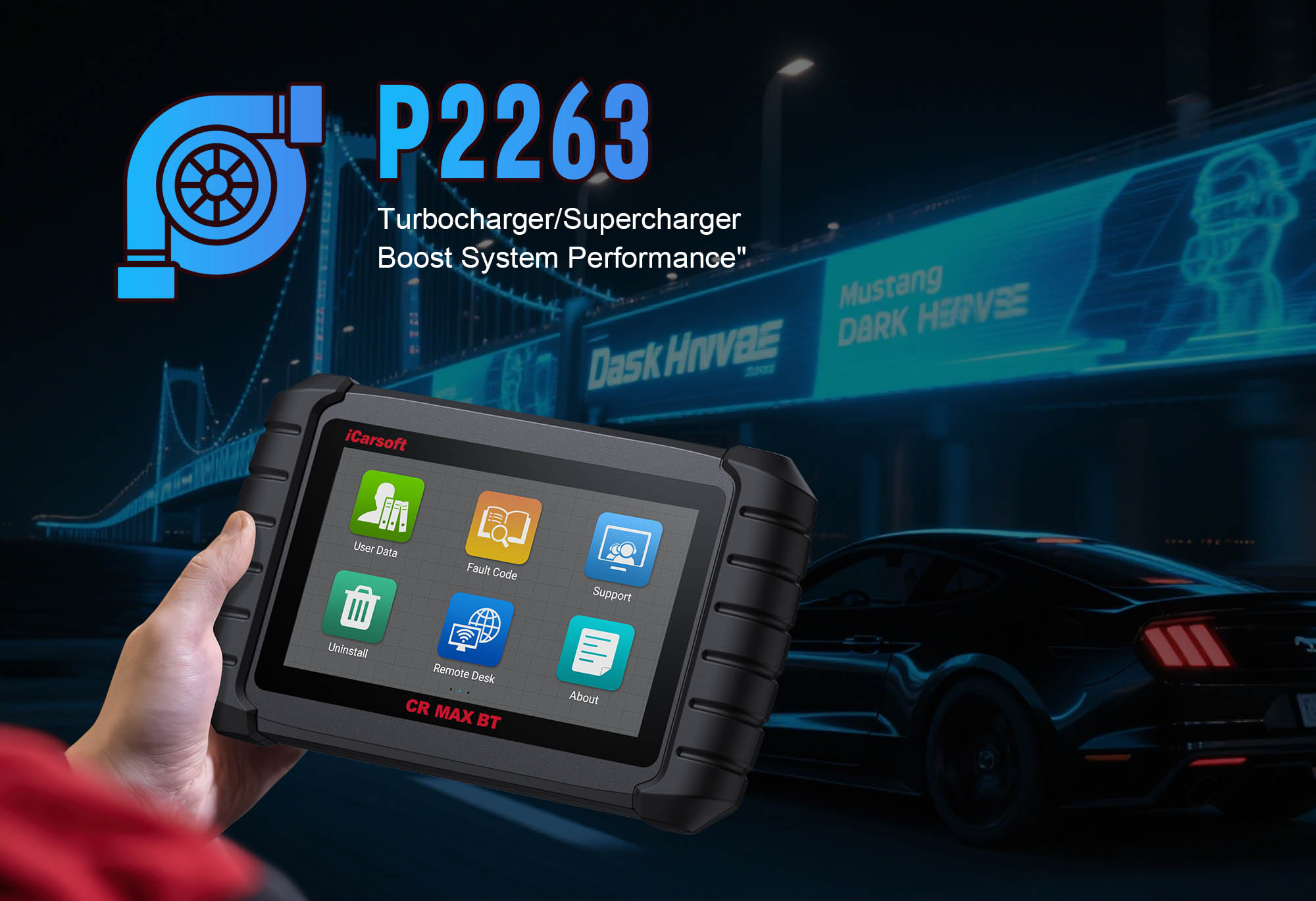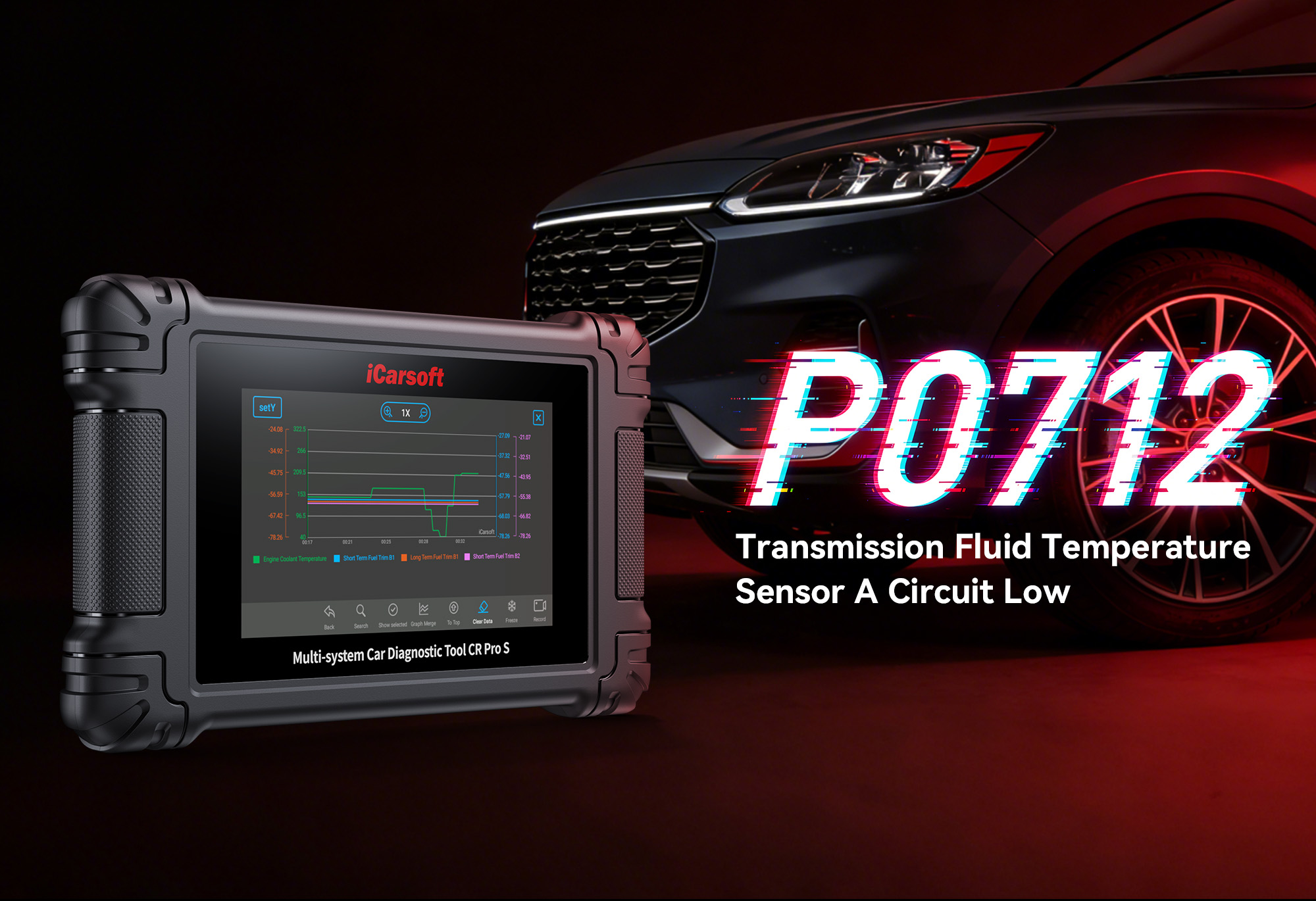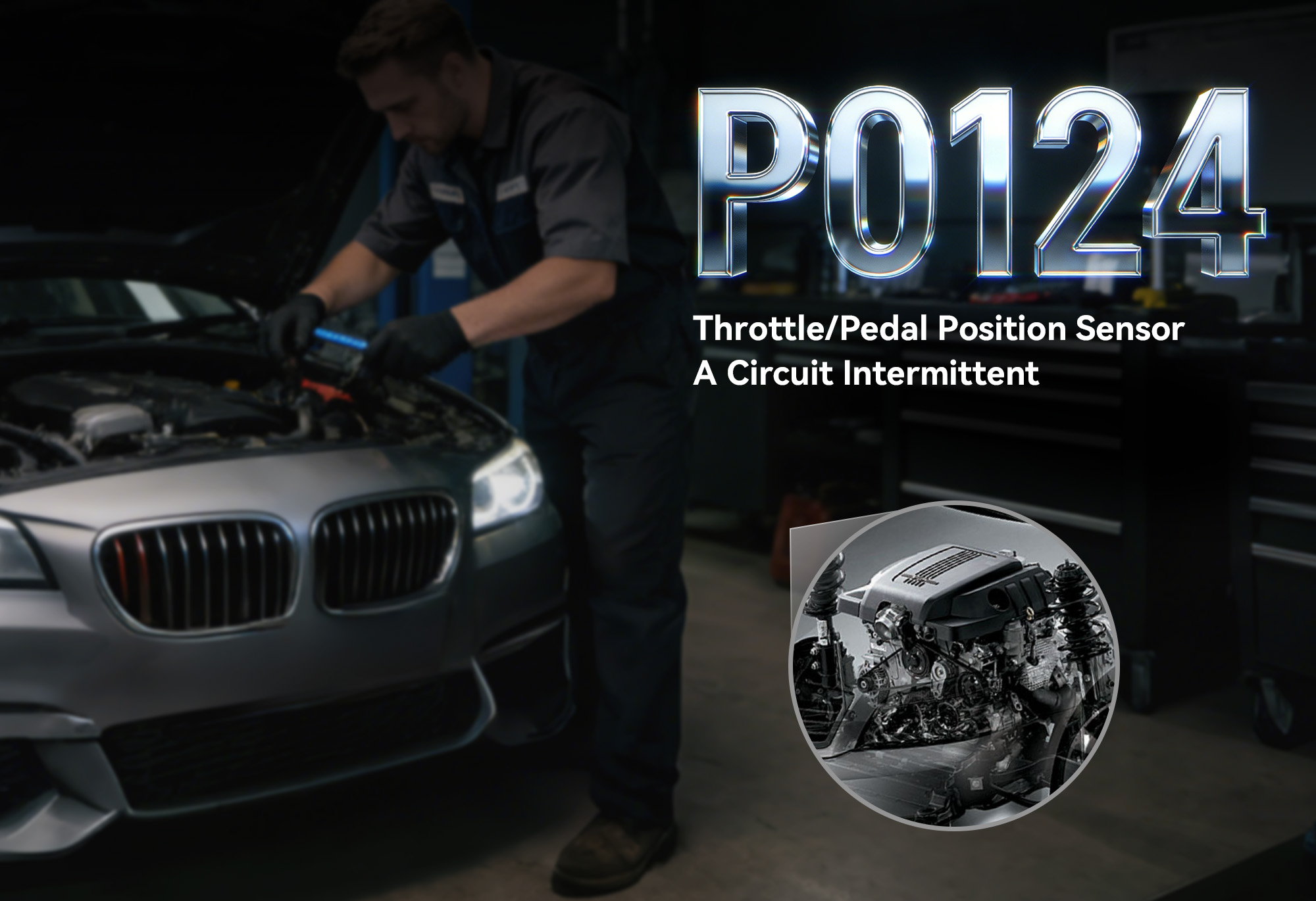Diagnose & Clear P2263 with iCarsoft CR MAX BT: Fix Diesel Particulate Filter (DPF) Pressure Sensor A Circuit High
If your diesel vehicle’s check engine light illuminates and a scan returns P2263, it’s a critical signal of a diesel particulate filter (DPF) system issue. This generic OBD-II code stands for "Diesel Particulate Filter Pressure Sensor A Circuit High"—meaning the Engine Control Module (ECM) has detected abnormally high voltage from the DPF pressure sensor, which monitors exhaust backpressure to assess DPF clogging levels.
The DPF pressure sensor is a linchpin of diesel emissions systems: it measures the pressure difference between the inlet and outlet of the DPF, telling the ECM how much soot has accumulated. When the sensor sends a "high circuit" signal (often above 4.5V), the ECM can’t accurately gauge DPF health—leading to failed regeneration cycles, reduced engine power, or even a "limp mode" to prevent damage. Left unaddressed, P2263 can cause DPF overheating, costly filter replacement, or non-compliance with emissions regulations.
Basic scanners might only label P2263 as a "DPF sensor fault" but can’t distinguish between a faulty sensor, damaged wiring, or a clogged DPF. The iCarsoft CR MAX BT—with its wireless connectivity, DPF-specific diagnostics, and real-time pressure monitoring—solves this. Let’s walk through how to diagnose and resolve P2263.
Why It Matters
Ignoring P2263 puts your diesel vehicle’s emissions system and engine at risk. A faulty DPF pressure sensor tricks the ECM into mismanaging regeneration (the process that burns accumulated soot): if the ECM thinks pressure is too high (due to P2263), it may skip regeneration—causing the DPF to clog with soot. A clogged DPF increases exhaust backpressure, forcing the engine to work harder (reducing fuel economy by 10–15%) and potentially damaging the turbocharger (a $1,500–$3,000 repair).
For diesel vehicles in emissions-testing states, P2263 guarantees a failed test—costing re-test fees and potential fines. In severe cases, the ECM triggers limp mode (max speed ~40 mph) to protect the DPF from rupture, stranding you unexpectedly. Addressing P2263 promptly with the CR MAX BT not only restores emissions compliance but also prevents expensive DPF/turbocharger damage.
Understanding P2263: Causes & Key Symptoms
To tackle P2263 effectively, first map its impact on your diesel vehicle’s DPF system and performance:
Key Symptoms of P2263
-
Dual Warning Lights: Check engine light + DPF warning light (or "DPF Full" message on the dashboard) illuminate together.
-
Failed DPF Regeneration: The ECM skips active regeneration (burning soot at high temperatures) because it can’t trust faulty pressure data—accelerating DPF clogging.
-
Reduced Power: Engine output drops by 20–30% as the ECM limits performance to avoid DPF overpressure.
-
Increased Fuel Consumption: Inefficient combustion from incomplete regeneration wastes diesel fuel.
-
Limp Mode Activation: Severe cases trigger limp mode—max speed ~40 mph, no turbo boost, and restricted acceleration.
-
Emissions Test Failure: High soot levels from a neglected DPF cause excess hydrocarbons (HC) and particulate matter (PM), failing state inspections.
Common Causes of P2263
|
Cause
|
Description
|
|
Faulty DPF Pressure Sensor
|
Internal resistor failure or contaminated sensor ports (soot/debris) cause erratic high-voltage signals (above 4.5V).
|
|
Wiring Issues
|
Damaged insulation, short circuits (signal wire touching 5V reference), or corrosion in the sensor’s connector/harness disrupt voltage.
|
|
Clogged DPF Pressure Tubes
|
Soot or carbon buildup blocks the sensor’s inlet/outlet tubes, creating false high-pressure readings that trigger P2263.
|
|
DPF Overloading
|
Excessive soot accumulation (from short trips, low-quality diesel, or failed regeneration) forces the sensor to register abnormal pressure.
|
|
ECM Software Glitches
|
Outdated ECM firmware misinterprets valid sensor signals (e.g., 3.5V under load) as "high circuit" errors.
|
|
Water Intrusion
|
Moisture in the sensor connector or wiring harness short-circuits the signal, causing voltage spikes.
|
Why iCarsoft CR MAX BT Excels at Diagnosing P2263
The CR MAX BT is purpose-built for diesel DPF systems, outperforming basic scanners with DPF-specific tools and wireless convenience:
DPF System Deep Scan
Reads fault codes from both ECM and DPF control modules—distinguishes P2263 triggers (e.g., failed regeneration vs. sensor failure).
Real-Time Pressure & Voltage Monitoring
Displays live DPF pressure difference (1–5 kPa at idle) and sensor voltage (0.5–4.5V)—spots if high voltage correlates with actual backpressure.
Wireless Regeneration Tests
Initiates active/passive regeneration wirelessly—tests if the sensor works during normal DPF cleaning cycles (no cables limiting movement).
Vehicle-Specific DPF Data
Preloaded with sensor locations, tube routing, and regeneration specs for 58 diesel makes (Ford F-250, Chevy Silverado Duramax, VW Golf TDI).
DPF Soot Load Calculation
Estimates soot levels (%) via live data—helps you distinguish sensor faults from actual DPF clogging (no guesswork).
Auto VIN Detection
Identifies diesel engine type (6.7L Power Stroke, 3.0L EcoDiesel) to load accurate pressure/voltage parameters for P2263 diagnosis.
Step-by-Step: Diagnose P2263 with iCarsoft CR MAX BT
-
1. Connect Wirelessly & Confirm the Code
1. Plug the CR MAX BT’s OBD-II adapter into your vehicle’s port (under the dashboard).
2. Pair the scanner with the adapter via Bluetooth (follow on-screen prompts for iOS/Android—takes 30 seconds).
3. Select your vehicle via Auto VIN (scans VIN in 2 seconds) or manual entry (make/model/year/engine—critical for diesel specificity).
4. Navigate to Engine > Fault Codes > Read Codes to confirm P2263. Tap Code Details for vehicle-specific insights (e.g., "Ford: DPF Pressure Sensor A Voltage Above 4.7V" or "Chevrolet: Sensor Circuit High Input").
-
2. Check for Related DPF/Emissions Codes
P2263 rarely appears alone—scan for these companion faults to narrow the root cause:
- P2002/P2003: DPF Efficiency Below Threshold/Excessive Soot Load (actual DPF clogging)
- P2264: DPF Pressure Sensor A Circuit Low (complementary sensor issue)
- P2457: DPF Pressure Sensor "A" Circuit Range/Performance (erratic signal)
- P0401/P0404: EGR Flow Insufficient/Open Circuit (EGR issues affecting DPF)
Multiple codes = fix systemic issues (e.g., clean DPF + replace sensor) instead of just one component.
-
3. Monitor Live DPF Sensor Data
Use wireless real-time data to isolate voltage/pressure irregularities:
1. Go to Engine > Live Data > DPF System and select:
- "DPF Pressure Sensor A Voltage" (normal: 0.5V–4.5V; >4.5V = P2263 trigger)
- "DPF Pressure Difference" (inlet vs. outlet—normal: 1–5 kPa at idle; >10 kPa = clogged DPF)
- "DPF Regeneration Status" (shows "Active," "Passive," or "Skipped")
2. Start the engine and let it reach operating temperature (10–15 minutes, coolant temp >80°C):
- Voltage stuck at 5V = short circuit or sensor failure
- Voltage spikes with no pressure increase = faulty sensor or clogged tubes
- Pressure >15 kPa + normal voltage = clogged DPF (not a sensor issue)
-
4. Inspect the DPF Pressure Sensor & Tubes
Use the CR MAX BT’s Component Location tool to find the sensor (mounted on the exhaust manifold/DPF housing, with 2 small tubes + 3-wire connector):
Sensor Inspection
1. Check for soot buildup on the sensor body/ports—clean with a soft brush (avoid sharp tools).
2. Disconnect the electrical connector:
- Look for green/white corrosion or bent pins.
- Clean with electrical contact cleaner and dry with compressed air.
Tube Inspection
1. Remove the sensor’s inlet/outlet tubes (follow torque specs in the CR MAX BT’s Service Manual—typically 5–8 ft-lbs).
2. Check for clogging: Blow compressed air through the tubes (wear safety glasses) to clear soot.
3. Replace tubes if cracked, brittle, or permanently clogged.
-
5. Test DPF Sensor Circuit Integrity
Verify electrical connections with the CR MAX BT (no separate multimeter needed):
1. Turn off the engine and keep the sensor connector disconnected.
2. Navigate to Special Functions > Circuit Tests > DPF Sensor Wiring.
3. Run three critical tests:
- 5V Reference: Measure voltage at the sensor’s 5V pin (4.8–5.2V = healthy; no voltage = wiring break/ECM issue).
- Ground: Check resistance between ground pin and battery negative (<0.5Ω = good; high resistance = corroded ground).
- Short Circuit Check: Test if signal wire touches 5V reference (continuity = short—repair damaged wiring).
-
6. Perform DPF Regeneration Test
Validate sensor performance during active regeneration (critical for diesel DPF systems):
1. Prep the vehicle:
- At least 1/4 tank of diesel.
- Park in a well-ventilated area (regeneration produces heat).
- Ensure no flammable materials are near the exhaust.
2. Navigate to Special Functions > DPF > Active Regeneration.
3. Follow on-screen prompts (e.g., "Engine temp must be >60°C")—the CR MAX BT sends a command to the ECM to start regeneration.
4. Monitor live data during regeneration:
- Voltage should fluctuate 1V–3V with pressure changes (normal).
- No voltage change = faulty sensor (replace it).
- Voltage normal but P2263 returns = DPF overloading (needs cleaning).
-
7. Check DPF Soot Load & Clean if Needed
If pressure is high but sensor voltage is normal, address DPF clogging:
1. Use the CR MAX BT’s DPF Soot Load tool to estimate soot levels (%):
- <80% soot load: Run Passive Regeneration (drive at 60+ mph for 20 minutes to burn soot).
- >80% soot load: Perform Forced Regeneration via the CR MAX BT (follows manufacturer protocols to burn heavy soot).
2. If regeneration fails (CR MAX BT shows "Regen Incomplete"):
- Inspect the DPF for physical damage (e.g., cracks).
- Replace the DPF if cleaning doesn’t reduce soot load (follow the CR MAX BT’s DPF Replacement Guide).
-
8. Update ECM Firmware
Outdated software often misinterprets DPF sensor signals—fix with the CR MAX BT:
1. Connect the scanner to Wi-Fi (required for updates).
2. Navigate to Special Functions > Engine > ECM Update.
3. The CR MAX BT checks for manufacturer firmware (critical for 2010+ diesels with DPF systems).
4. Follow prompts to install updates (do not turn off power—prevents ECM damage).
5. After update, clear P2263 and re-test—many cases are resolved by software fixes for sensor calibration.
-
9. Repair & Clear P2263
Fix the root cause based on diagnostics:
- Faulty Sensor: Replace with OEM part (use Part Lookup—e.g., Bosch 0281006055, Denso 22630-30010). Torque to specs (5–7 ft-lbs).
- Clogged Tubes/Wiring: Replace tubes; splice frayed wires with heat-shrink connectors.
- Clogged DPF: Perform forced regeneration or replace the filter (use the CR MAX BT’s DPF Reset to clear soot count).
- Short Circuit: Repair damaged wiring and insulate with heat-shrink tubing.
Clear the code: Navigate to Engine > Fault Codes > Clear Codes to delete P2263 and related DPF faults.
-
10. Verify the Repair
Comprehensive testing ensures DPF system health:
1. Regeneration Validation: Drive at 60+ mph for 20 minutes—use the CR MAX BT to confirm passive regeneration completes successfully.
2. Pressure Check: Recheck live data at idle (pressure difference 1–5 kPa, voltage 0.5–4.5V).
3. Soot Load Reset: If you replaced the DPF, use Special Functions > DPF > Soot Load Reset to reset the ECM’s soot count.
4. Test Drive: 30-minute drive including:
- Highway acceleration (no reduced power).
- Idle (no warning lights).
- Short stops (no regeneration failures).
5. Re-scan: No P2263 + normal DPF data = successful repair.
Summary Table
|
Step
|
Action
|
|
1
|
Pair CR MAX BT wirelessly, confirm P2263, and review vehicle-specific details
|
|
2
|
Scan for related DPF/emissions codes
|
|
3
|
Monitor live DPF sensor voltage and pressure difference
|
|
4
|
Inspect DPF pressure sensor and tubes for damage/clogging
|
|
5
|
Test DPF sensor circuit (5V, ground, short circuit check)
|
|
6
|
Perform active regeneration test to validate sensor
|
|
7
|
Check DPF soot load; clean/replace DPF if overloaded
|
|
8
|
Update ECM firmware via Wi-Fi
|
|
9
|
Repair root cause and clear P2263
|
|
10
|
Test regeneration, pressure, and drive to verify repair
|
Conclusion
P2263’s "DPF sensor high circuit" label can be misleading—what seems like a $100 sensor replacement might actually be a $20 tube cleaning or free firmware update. The iCarsoft CR MAX BT eliminates guesswork with DPF-specific tools, real-time pressure monitoring, and wireless regeneration tests, ensuring you fix the root cause (not just replace parts).
Whether you’re servicing a Ford F-250 Power Stroke or a Volkswagen Golf TDI, the CR MAX BT’s diesel-focused features make P2263 diagnosis accessible. By following this guide, you’ll restore emissions compliance, protect your DPF and turbocharger, and keep your diesel vehicle running efficiently—all without tangled cables or expensive dealer visits.
FAQs About P2263 Code
Q: Can I drive my diesel vehicle with P2263?
A: Short trips (e.g., to a repair shop) are possible, but avoid long drives. P2263 causes failed regeneration, leading to DPF clogging and reduced power. If limp mode activates, stop driving—further use can damage the turbocharger or DPF (costly to replace).
Q: Will replacing the DPF pressure sensor always fix P2263?
A: No—only if the sensor itself is faulty. The CR MAX BT’s tests confirm this: if circuit tests pass, tubes are clean, and pressure is normal, replace the sensor. If the DPF is clogged or wiring is shorted, replacing the sensor ($50–$150) won’t resolve P2263.
Q: Why does my diesel vehicle fail regeneration after fixing P2263?
A: Regeneration fails if the DPF is already overloaded with soot (even after fixing the sensor). Use the CR MAX BT’s Forced Regeneration function to burn heavy soot. If that fails, the DPF may be physically damaged (e.g., cracked) and require replacement.
Q: How much does it cost to fix P2263?
A: Costs vary by cause: Sensor replacement = $50–$150 (DIY); Tube cleaning/replacement = $20–$50; DPF cleaning = $0 (DIY with CR MAX BT); DPF replacement = $800–$2,500 (professional); ECM update = $0 (DIY). The CR MAX BT helps avoid expensive fixes by identifying low-cost issues first.





